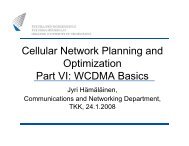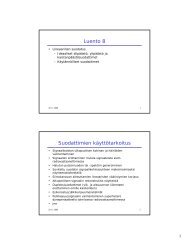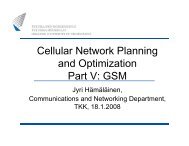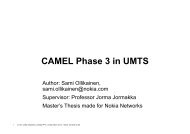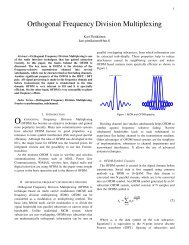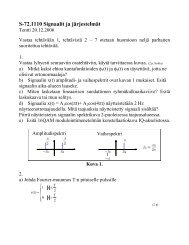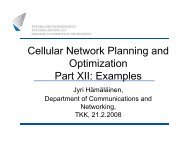WPAN – Wireless Personal Area Networks 1. Introduction and ...
WPAN – Wireless Personal Area Networks 1. Introduction and ...
WPAN – Wireless Personal Area Networks 1. Introduction and ...
You also want an ePaper? Increase the reach of your titles
YUMPU automatically turns print PDFs into web optimized ePapers that Google loves.
<strong>WPAN</strong> – <strong>Wireless</strong> <strong>Personal</strong> <strong>Area</strong> <strong>Networks</strong><br />
S-72.4210 Post-Graduate Course in<br />
Radio Communications<br />
February 21, 2006<br />
Jussi Salmi<br />
Signal Processing Lab./SMARAD,<br />
TKK, Espoo, Finl<strong>and</strong><br />
Outline<br />
2<br />
<strong>1.</strong> <strong>Introduction</strong> <strong>and</strong> applications<br />
2. <strong>WPAN</strong> Topologies<br />
3. IEEE 802.15 <strong>WPAN</strong> Working Group<br />
• Dominating st<strong>and</strong>ard – Bluetooth<br />
• High Rate <strong>WPAN</strong> IEEE 802.15.3<br />
• Low Rate <strong>WPAN</strong> IEEE 802.15.4<br />
• Mesh <strong>WPAN</strong> IEEE 802.15.5<br />
4. Conclusions<br />
5. References<br />
6. Homework<br />
Jussi Salmi<br />
21 Feb. 2006
<strong>Introduction</strong><br />
3<br />
• <strong>Wireless</strong><strong>Personal</strong><strong>Area</strong><strong>Networks</strong><br />
– Person centered short-range wireless connectivity<br />
Jussi Salmi<br />
21 Feb. 2006<br />
Applications<br />
4<br />
• Applications include<br />
– Short-range (< 10 m) connectivity for multimedia<br />
applications<br />
• PDAs, Cameras, Voice (h<strong>and</strong>s free devices)<br />
• High QoS, high data rate (IEEE 802.15.3)<br />
– Industrial sensor applications<br />
• Low speed, low battery, low cost sensor networks (IEEE<br />
802.15.4)<br />
Common goals<br />
• Getting rid of cable connections<br />
• Little or no infrastructure<br />
• Device interoperability<br />
Jussi Salmi<br />
21 Feb. 2006
Acronyms <strong>and</strong> abbreviations<br />
5<br />
CAP<br />
CFP<br />
CSMA-CA<br />
CSS<br />
CTA<br />
DEV<br />
GTS<br />
FFD<br />
LR-<strong>WPAN</strong><br />
MAC<br />
MCTA<br />
PAN<br />
PHY<br />
PPDU<br />
QoS<br />
RFD<br />
UWB<br />
WLAN<br />
WMAN<br />
<strong>WPAN</strong><br />
contention access period<br />
contention-free period<br />
carrier sense multiple access with collision avoidance<br />
chirp spread spectrum<br />
channel time allocation<br />
a short for single device in <strong>WPAN</strong> piconet<br />
guaranteed time slot<br />
full-function device<br />
low-rate wireless personal area network<br />
medium access control<br />
management CTA<br />
personal area network<br />
physical layer<br />
PHY protocol data unit<br />
quality of service<br />
reduced-function device<br />
ultra wide b<strong>and</strong><br />
wireless local area network<br />
wireless metropolitan area network<br />
wireless personal area network<br />
Jussi Salmi<br />
21 Feb. 2006<br />
<strong>WPAN</strong> Topologies [6]<br />
6<br />
Mesh<br />
Star<br />
Cluster Tree<br />
PAN coordinator<br />
Full Function Device<br />
Reduced Function Device<br />
Jussi Salmi<br />
21 Feb. 2006
IEEE 802.15 <strong>WPAN</strong> Working Group<br />
7<br />
IEEE 802<br />
LAN/MAN St<strong>and</strong>ards Committee<br />
Active Work Groups<br />
802.1 High Level Interface<br />
802.3 Ethernet<br />
802.11 WLAN<br />
IEEE 802.15 <strong>Wireless</strong> <strong>Personal</strong> <strong>Area</strong><br />
Network (<strong>WPAN</strong>) Working Group<br />
Task Group 1 <strong>WPAN</strong>/Bluetooth<br />
Task Group 2 Coexistence<br />
802.15 <strong>WPAN</strong><br />
802.16 WMAN<br />
802.17 Resilient Packet Ring<br />
802.18 Radio Regulatory<br />
802.19 Coexistence<br />
802.20 Mobile Broadb<strong>and</strong> <strong>Wireless</strong> Access<br />
802.21 Media Independent H<strong>and</strong>off<br />
Task Group 3 <strong>WPAN</strong> High Rate<br />
Task Group 4 <strong>WPAN</strong> Low Rate<br />
Task Group 5 <strong>WPAN</strong> Mesh<br />
802.22 <strong>Wireless</strong> Regional <strong>Area</strong> <strong>Networks</strong><br />
Jussi Salmi<br />
21 Feb. 2006<br />
IEEE 802.15 <strong>WPAN</strong> St<strong>and</strong>ards<br />
8<br />
IEEE 802.15 (<strong>WPAN</strong>) st<strong>and</strong>ards (table from [1])<br />
Jussi Salmi<br />
21 Feb. 2006
Bluetooth - Dominating st<strong>and</strong>ard<br />
9<br />
• Bluetooth is the base for IEEE Std 802.15.1-<br />
2002 (rev. 2005)<br />
– Data rate of 1 Mb/s (2 or 3 Mb/s with enhanced<br />
data rate)<br />
– Robust short range communications<br />
Data/Voice<br />
Access<br />
Points<br />
Cable<br />
Replacement<br />
<strong>Personal</strong> Ad-hoc<br />
Connectivity<br />
Jussi Salmi<br />
21 Feb. 2006<br />
IEEE 802.15 <strong>WPAN</strong> High Rate (HR) Task Group 3<br />
10<br />
• Task Group 3<br />
– First high rate <strong>WPAN</strong> st<strong>and</strong>ard: IEEE Std 802.15.3-<br />
2003 (HR-<strong>WPAN</strong>)<br />
• Task Group 3a<br />
– Alternative PHY using UWB<br />
• Task Group 3b<br />
– Improved implementation <strong>and</strong> interoperability of the<br />
IEEE Std 802.15.3 MAC<br />
– Expected outcome during 2006<br />
• Task Group 3c<br />
– <strong>WPAN</strong> at mm-waves (57-64 GHz)<br />
Jussi Salmi<br />
21 Feb. 2006
IEEE Std 802.15.3-2003 (HR) (1)<br />
11<br />
• <strong>WPAN</strong> with high data rate (HR) IEEE Std<br />
802.15.3-2003<br />
– Data rates from 11 Mbps to 55 Mbps<br />
– Ad hoc peer-to-peer networks (piconets)<br />
– Each piconet is controlled by piconet coordinator<br />
(PNC)<br />
• Sends beacon for piconet information <strong>and</strong> timing<br />
• Controls superframe structures<br />
Jussi Salmi<br />
21 Feb. 2006<br />
IEEE Std 802.15.3-2003 (HR) (2)<br />
12<br />
• Single carrier of 15 MHz b<strong>and</strong>width <strong>and</strong> trellis coding<br />
• Frequency b<strong>and</strong> of 2.4-2.4835 GHZ<br />
– Coexistence with 802.11b<br />
• Passive scanning<br />
• Dynamic channel selection<br />
• A channel plan that minimize<br />
channel overlap<br />
• Transmit power control<br />
Jussi Salmi<br />
21 Feb. 2006
IEEE Std 802.15.3-2003 (HR) (3)<br />
13<br />
• Piconet timing is based on superframes<br />
Piconet information<br />
Timing allocation<br />
Communication between<br />
PNC <strong>and</strong> other DEVs<br />
(optional)<br />
Asynchronous CSMA/CA<br />
transmission (optional)<br />
TDMA based access channels assigned to DEVs by PNC<br />
CTA lengths depend on DEVs QoS requirements.<br />
Jussi Salmi<br />
21 Feb. 2006<br />
IEEE 802.15 <strong>WPAN</strong> Task Group 3a<br />
14<br />
• In 2003 Task Group 3a was formed for even higher data<br />
rates utilizing UWB at 3.1 – 10.6 GHz<br />
• Two c<strong>and</strong>idate proposals were merged (out of 23)<br />
<strong>1.</strong> MultiB<strong>and</strong> OFDM (MB-OFDM)<br />
• Supported by WiMedia Alliance (HP, Intel, Microsoft, Nokia etc.)<br />
• Data rates from 53.3 Mbps to 480 Mbps<br />
• 122 sub-carriers, QPSK modulation<br />
2. Direct sequence-UWB (DS-UWB)<br />
• Supported by UWB Forum (Motorola, Mitsubishi, U.S. Navy etc.)<br />
• Data rates from 28 Mbps to 1320 Mbps<br />
• Direct sequence spreading (DSS) for pulses of binary phase shift<br />
keying (BPSK) <strong>and</strong> quatemary bi-orthogonal keying (4BOK)<br />
• Project was dissoluted in Jan 2006 after long lasting<br />
fight between the two proposals<br />
Jussi Salmi<br />
21 Feb. 2006
IEEE 802.15 <strong>WPAN</strong> Task Group 3c<br />
15<br />
• mm-<strong>WPAN</strong><br />
– High b<strong>and</strong>width (57-64 GHz) -> high data rate (2 Gbps<br />
required, 3 Gbps desired)<br />
• Replacement of all cables, e.g., HDTV video from receiver to<br />
projector<br />
– Allows high coexistence with current systems<br />
• No competitors yet on the same b<strong>and</strong><br />
– High free space loss<br />
• Good for frequency re-use<br />
• Fits to <strong>WPAN</strong> consept (< 10 m distance)<br />
– St<strong>and</strong>ard expected to be released during 2007 with<br />
first implementations during 2008<br />
Jussi Salmi<br />
21 Feb. 2006<br />
IEEE 802.15 <strong>WPAN</strong> Low Rate (LR) Task Group 4<br />
16<br />
• Task Group 4<br />
– LR-<strong>WPAN</strong> St<strong>and</strong>ard: IEEE Std 802.15.4-2003 (LR<br />
<strong>WPAN</strong>)<br />
– Also known as ZigBee<br />
• Task Group 4a<br />
– Alternative PHYs: UWB Impulse Radio <strong>and</strong> Chirp<br />
Spread Spectrum (CSS)<br />
• Task Group 4c<br />
– Specific enhancements <strong>and</strong> clarifications to the IEEE<br />
Std 802.15.4-2003<br />
Jussi Salmi<br />
21 Feb. 2006
IEEE Std 802.15.4-2003 (LR) (1)<br />
17<br />
• <strong>WPAN</strong> for low data rate (LR-<strong>WPAN</strong>) IEEE Std 802.15.4-<br />
2003<br />
– Low complexity<br />
– Multi-month to multi-year battery life<br />
– Peer-to-peer <strong>and</strong> star topologies<br />
– Data rates from 20 kb/s (@868 MHz) to 250 kb/s (@2450 MHz)<br />
• Applications<br />
– Sensors, interactive toys (joysticks etc.), remote controls<br />
Frequency b<strong>and</strong>s <strong>and</strong> data rates for IEEE Std 802.15.4<br />
Jussi Salmi<br />
21 Feb. 2006<br />
IEEE Std 802.15.4-2003 (LR) (2)<br />
18<br />
• Two types of devices<br />
– Full-function (FFD) <strong>and</strong> reduced-function (RFD)<br />
• FFD can perform as PAN coordinator<br />
– Controls an optional superframe structure<br />
• Provides beacons for synchronization <strong>and</strong> optional guaranteed<br />
time slots for low-latency applications<br />
Devices compete for access<br />
(slotted CSMA-CA)<br />
Guaranteed time<br />
slots (GTSs)<br />
Jussi Salmi<br />
21 Feb. 2006
IEEE Std 802.15.4-2003 (LR) (3)<br />
19<br />
• Modulation <strong>and</strong> spreading (@ 2450 MHz)<br />
Jussi Salmi<br />
21 Feb. 2006<br />
Battery Life Case Study –Peel ‘N Stick Security Sensors<br />
(Current IEEE 802.15.4 compliant hardware)<br />
20<br />
Any check-in interval<br />
exceeding ~14 sec allows<br />
sensor to surpass alkaline<br />
battery shelf life<br />
2 AA Alkaline Batteries!<br />
Events/day<br />
Source: [5]<br />
Jussi Salmi<br />
21 Feb. 2006
Differences: Bluetooth vs. ZigBee (TG4) [7]<br />
21<br />
• Modulation technique<br />
Bluetooth: Frequency Hopping Spread Spectrum (FHSS)<br />
ZigBee: Direct Sequence Spread Spectrum (DSSS)<br />
• Protocol stack size<br />
Bluetooth: 250K bytes<br />
ZigBee: 28K bytes<br />
• Battery<br />
Bluetooth: Intended for frequent recharging<br />
ZigBee: Not rechargeable (one reason batteries will last for up to 10 years)<br />
• Maximum network speed<br />
Bluetooth: 1M bit/sec<br />
ZigBee: 250K bit/sec<br />
• Network range<br />
Bluetooth: 1 or 100 meters, depending on radio class<br />
ZigBee: Up to 70 meters<br />
• Typical network join time<br />
Bluetooth: 3 seconds<br />
ZigBee: 30 milliseconds<br />
Jussi Salmi<br />
21 Feb. 2006<br />
IEEE 802.15 <strong>WPAN</strong> Task Group 5 (TG5)<br />
22<br />
• PHY <strong>and</strong> MAC layer mechanisms for mesh<br />
networking<br />
• Mesh topology allows:<br />
I. Network coverage extension<br />
II.<br />
III.<br />
Enhanced reliability via route redundancy<br />
Easier network configuration<br />
IV. Battery life due to fewer retransmissions<br />
Jussi Salmi<br />
21 Feb. 2006
IEEE 802.15.5 <strong>WPAN</strong> Mesh<br />
23<br />
• Additional promises made by the Mesh Task Group:<br />
– Extends distance <strong>and</strong> communication speed<br />
– Allows effortless installation of a communications infrastructure<br />
– Self-configures, is self diagnostic <strong>and</strong> self-healing<br />
– Provides resiliency, with no single point of failure<br />
5m / 250Mbs<br />
C<br />
5m / 250Mbs<br />
A<br />
10m / 100Mbs<br />
B<br />
Enhancing communication speed<br />
Jussi Salmi<br />
21 Feb. 2006<br />
Conclusions<br />
24<br />
• IEEE 802.15 <strong>WPAN</strong> Work Group was introduced<br />
– <strong>WPAN</strong> st<strong>and</strong>ards under active development<br />
• Increasing data rates to be expected<br />
• Low power consumption<br />
• Self-configuring networks<br />
• Coexistense of 802.11 is an issue<br />
• Future <strong>WPAN</strong> interests<br />
– mm-wave systems (@ 60 GHz)<br />
– Mesh networks (relaying)<br />
– MIMO?<br />
• Not (yet) implicitly included in IEEE 802.15 framework<br />
• Enables enhanced reliability (diversity techniques) <strong>and</strong><br />
capacity (spatial multiplexing)<br />
Jussi Salmi<br />
21 Feb. 2006
References<br />
25<br />
[1] IEEE 802.15 Working Group for <strong>WPAN</strong>, http://ieee802.org/15/index.html<br />
[2] R. Prasad <strong>and</strong> L. Gavrilovska, ”Research Challenges for <strong>Wireless</strong> <strong>Personal</strong><br />
<strong>Area</strong> <strong>Networks</strong>”, http://www.eng.ukm.my/~micc2001/html/prasad.pdf<br />
[3] T. Siep, "IEEE 802.15.1 Tutorial", Texas Instruments,<br />
http://grouper.ieee.org/groups/802/15/pub/2001/Jan01/01046r1P802-15_WG-802-15-1-TG1-<br />
Tutorial.ppt<br />
[4] G. Roberts, "IEEE 802.15 Overview of WG <strong>and</strong> Task Groups ",<br />
STMicroelectronics, http://grouper.ieee.org/groups/802/15/pub/2003/Jan03/03053r0P802-<br />
15_PC-Overview-of-WG15-<strong>and</strong>-Task-Groups.ppt<br />
[5] F. Martin, et. All, “IEEE 802.15.4 PHY Capabilities”, May 2004,<br />
http://grouper.ieee.org/groups/802/15/pub/04/15-04-0227-03-004a-ieee-802-15-4-phy-layer<strong>and</strong>-implementation.ppt<br />
[6] Ed Callaway, Motorola, “ZigBee Tutorial”, July 2003,<br />
http://grouper.ieee.org/groups/802/15/pub/03/15-03-0305-00-0040-zigbee-tutorial.ppt<br />
[7] D. Rotella <strong>and</strong> R. Rotella, “IEEE 802.15.3a”,<br />
http://faculty.eng.fiu.edu/~zhuha/tnc6270/presentations_slides/IEEE802153a.ppt<br />
Jussi Salmi<br />
21 Feb. 2006<br />
Homework<br />
26<br />
I. In the IEEE Std 802.15.4 (Low Rate <strong>WPAN</strong>), the Offset-<br />
QPSK (O-QPSK) modulation is used for channels at 2.4<br />
GHz. Explain how O-QPSK differs from QPSK <strong>and</strong> what is<br />
the advantage of using it.<br />
II.<br />
Assuming you have the following device pairs/groups you<br />
wish to connect wireless:<br />
a) Video projector + HDTV receiver + Digital video camera (within 5<br />
m distance)<br />
b) H<strong>and</strong>s free headset + IP telephone (e.g. Skype) + Webcam + PC<br />
c) 4 joysticks + Video game console<br />
Please explain briefly which of the presented <strong>WPAN</strong><br />
solutions would you select for communication inside each<br />
of the groups (a-c). (The selected solution does not have<br />
to be currently on the market.)<br />
Jussi Salmi<br />
21 Feb. 2006





